INTRODUCTION
The need to shape a root canal root canal thoroughly is surely the primary purpose of any proper endodontic treatment.
Only by removing the canal content (whether organic or not) irrigants are able to carry out their action, allowing the sealer and the filling materials to seal the endodont.
For this purpose, different instrumentation methods have been developed over the years, making use of higher and higher performance materials; however, studies carried out so far, by using Micro-Ct, have shown that an endodontic area, up to 70%, depending on the root canal anatomy and the root canal section examined, is left untreated, i.e. uncleaned. (Fig 1-2) [36,37]
Instrumented Areas in Yellow – Non-instrumented Areas in Red
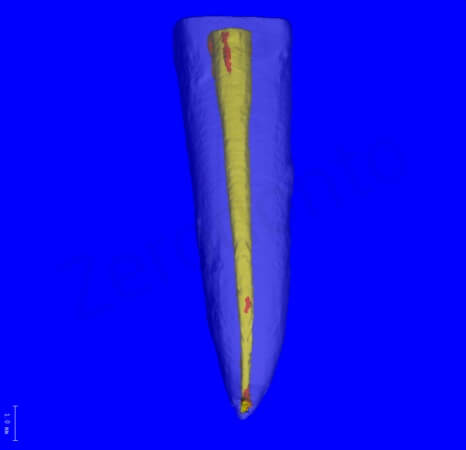
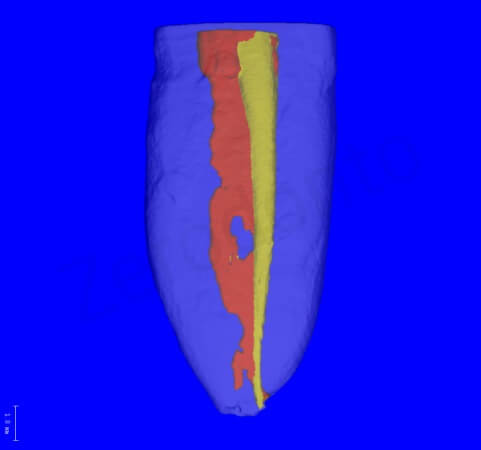
Clinical and product research has focused on problem solving by concentrating work in three direction
1- Improving irrigation
2- Creating new sealers
3- Creating new alloys for instruments
Irrigation and its issues associated with the various devices on the market were mentioned in a previous article on this blog [41] and (but), to date, there has been no further innovation, except for some studies on laser-assisted techniques (PIPS) [42]. However, there are still doubts about their efficacy, especially if we take into account the cost-benefit ratio.
As for As for new sealers (bioceramics), please refer to a further article that will deal with their characteristics and instructions for use.
In this article, we are going to describe the innovation brought to product research, regarding Ni-Ti instruments.
Dealing with instruments and instrumentation, the most worrying issue is the risk of fracture to which they are subject. Unless we are dealing with native structural imperfections (creep fracture) [23], first of all, we have to take into account the accumulation of cyclic fatigue to which the instruments are subject [24], and the torsional stress produced during cutting maneuvers.
Of course, the shaping quality goes hand in hand with the cleaning quality, because as long as cleaning is carried out , irrigants can penetrate and clean canal walls.
In order to reduce the stress to which the instruments are subjecsubject there was an initial attempt to modify the traditional continuous rotation movement by introducing reciprocating movementsreciprocating movements [25].
Considering that some studies claim that the reciprocation lengthens the life of instruments [26,30], some companies produced motors with specific movements, which increasingly reduce stress against canal wall, by creating dedicated movements as in the systematic Adaptive Motion Technology ™ (Kerr) [27] or Optimum Torque Reverse ™ (Morita) [31] (Fig.3-4).
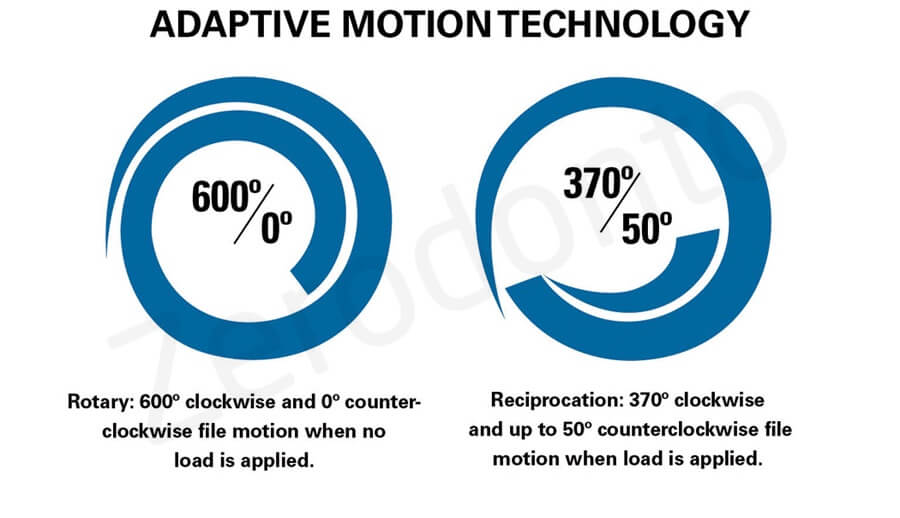
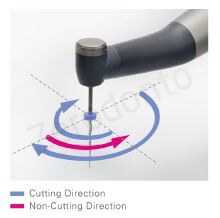
The aim is to reduce the surface contact of the instrument with the canal walls by preventing the blades from reaching stress point which may cause their deformation and breakage.
This happens mainly because all the instruments we are dealing with, work with higher or lower torque, depending on the instrument design.
However, these devices have not led to the resolution of the above mentioned problems.
Therefore, an attempt was made to improve the efficacy of the instruments, by processing Ni-TI bars with altered thermal cycles. This allowed various companies manufacture instruments , with an Martensitic-Austenitic transition (Fig5) occurring at temperatures which are different from the past [32]; they are more flexible and have a definitely higher tolerance of cyclic and torsional fatigue(than the past) [33,34], even if at the expense of cutting capacity.
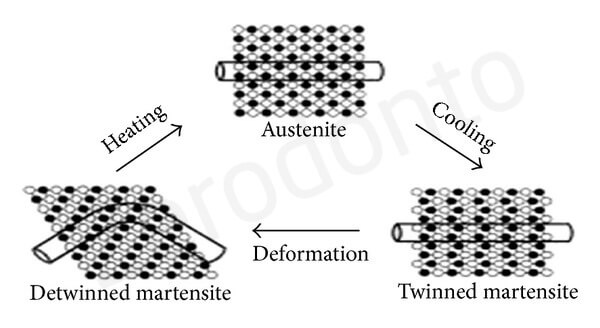
This led to the manufacturing of M-Wire ™ (Dentsply-Tulsa DentalSpecialities & WDV), R-Phase ™ (Kerr), CM-Wire ™ (ColtèneWhaledent), Blue ™ (Dentsply-Tulsa DentalSpecialities), Gold ™ (Dentsply-Tulsa DentalSpecialities) and Max-Wire ™ (FKG) : they were characterized by a martensitic—austenitic phase transformation point at different temperatures, thus obtaining instruments able to work in the martensitic phase at room temperature and return to the austenitic if heated and brought to their phase transformation point.
Transition temperatures range from M-> A are 17 ° C for R-Phase, 35 ° C for Max-Wire, 38 ° C for Blue, 50 ° C for M-Wire, 55 ° for CM and the Gold [23]
This way, the Ni-Ti polycrystalline structure is found at room temperatures in more plastic phases which, depending on the various commercial specifications, give individual instruments their characteristics.
From a clinical point of view, this turns into the opportunity to use files with a predominant Martensitic phase in curved channels and to choose instruments with a predominant Austenitic phase in all cases requiring greater rigidity of the instrument itself (calcified canals and retreatment).
The use of these new alloys makes it possible to increase the security level while using the instruments , and to reduce the apex transport likely to occurr; [39] However, there are still problems.
Studies carried out on reciprocal instruments, have reported a high percentage of debris accumulation [28] which, in some situations (isthmuses and ramifications) occlude part of the canal (Fig6)

The possibility to create dentinal micro-cracks during treatment at high torque has been reduced but not eliminated , [29,38] (Fig7), moreover, in some cases, the excessive flexibility of some instruments goes to the detriment of their cutting efficiency, but above all, an improvement of percentage of cleaned canal surface, mainly in oval canals, has not been achieved yet. (Fig8) [40].

Shemesh et al.
Instrumented Areas in Yellow – not instrumented Areas in Red
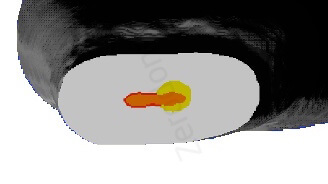
In order to achive a closer make contact with the canal walls , the axis movement of the instruments themselves has been changed, from traditional movements (rotating or reciprocating) with the rotation axis centered on the file flute, to instruments with eccentric movement as with Pro-TaperNext ™ (Dentsply-Sirona), Endosequence ™ (Brasseler USA) and TruShape ™ (Dentsply-Sirona) (Fig9)
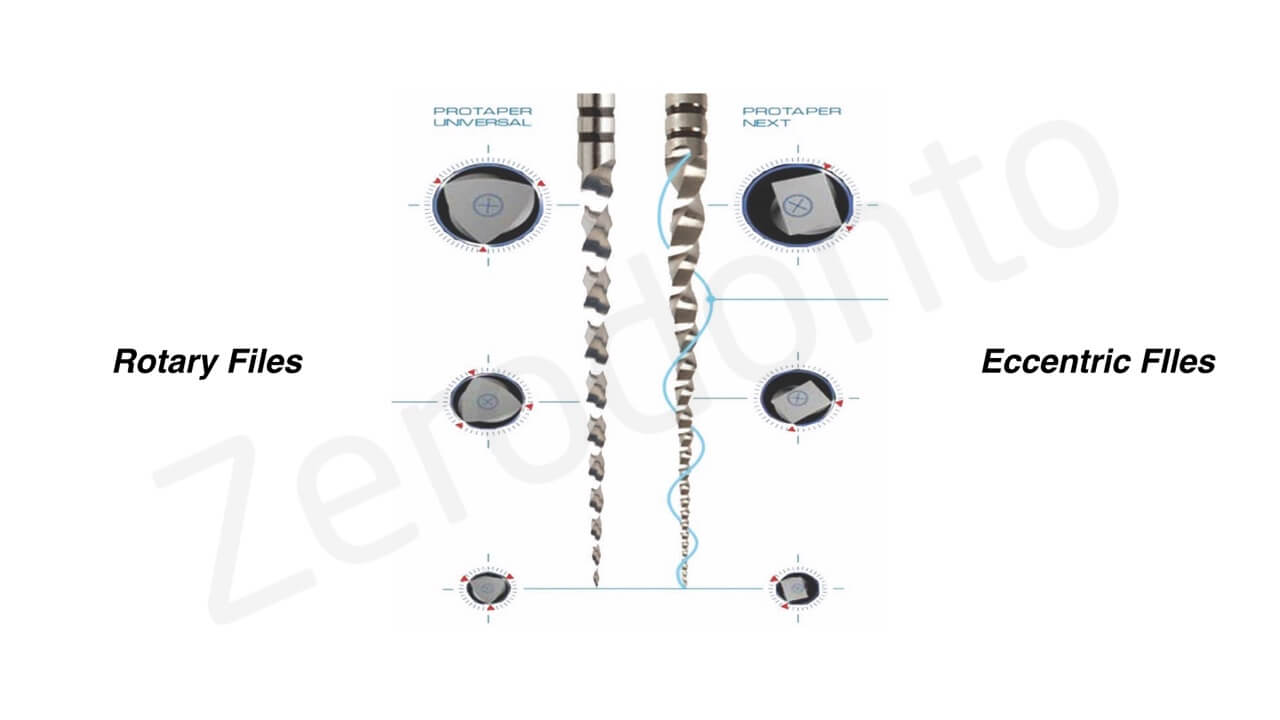
Apart from these two categories of instruments, there are also “expandable” instruments, wich are able to adapt themselves to the canal anatomy without causing any alteration, but trying to reach as large a surface as possible, due to their morphological characteristics.
This category includes SAF ™ (ReDent Nova-Israel) and Xp-EndoFinisher ™ and Xp-EndoShaper ™ (FKG- Swizerland) [43] and
“GentleFIle System” (MedicNRG,Kibbutz Afikim, Israel).
XP-EndoFinisher & XP-EndoShaper
As early as 2010, ReDent-Nova launched on the international market the SAF ™, [1], which revolutionized the concept of cleaning and shaping, by manufacturing an instrument that broadens the contact area within canal walls, thus cleaning up to 70%-80 % of the endodont.
In 2015, FKG manufactured an equally singular file, the XP-Endo-Finisher ™ (XPEF), which was born with the purpose of refining the canal after the shaping phase, in order to increase the effect of irrigants and improve smear-layer removal from the walls (fig1).
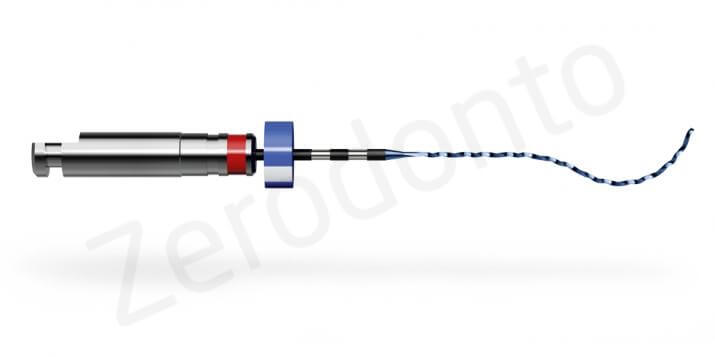
Unlike the SAF @,it can be used without a dedicated motor, and it works as a finisher at the end of an ordinary canal instrumentation sequence.
The instrument, made of an alloy patented by FKG called Max-Wire ™, and it remains in the martensitic phase state at room temperature (fig2), then it reaches a phase transformation at above 35 ° C
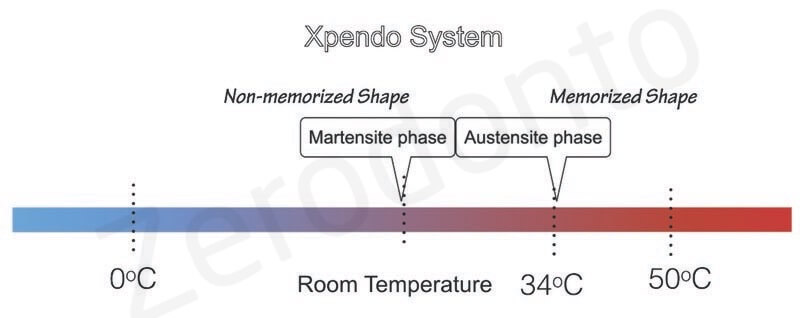
The instrument comes in a rigid plexiglass box, at the ends of which there are millimeter notches which make it possible to calculate the working length (LDL) before inserting the file inside the canal.
The instrument diameter is ISO # .25 and its taper is equal to 0. It is used at speeds of 800-1000 rpm at a torque of 1 as it does not perform any active cutting action.
In its austenitic phase, the file is characterized by the presence, in the last 10 mm of the working part, of a sort of hook shaped curve which allows to penetrate a larger canal surface than traditional instruments (fig. 3)
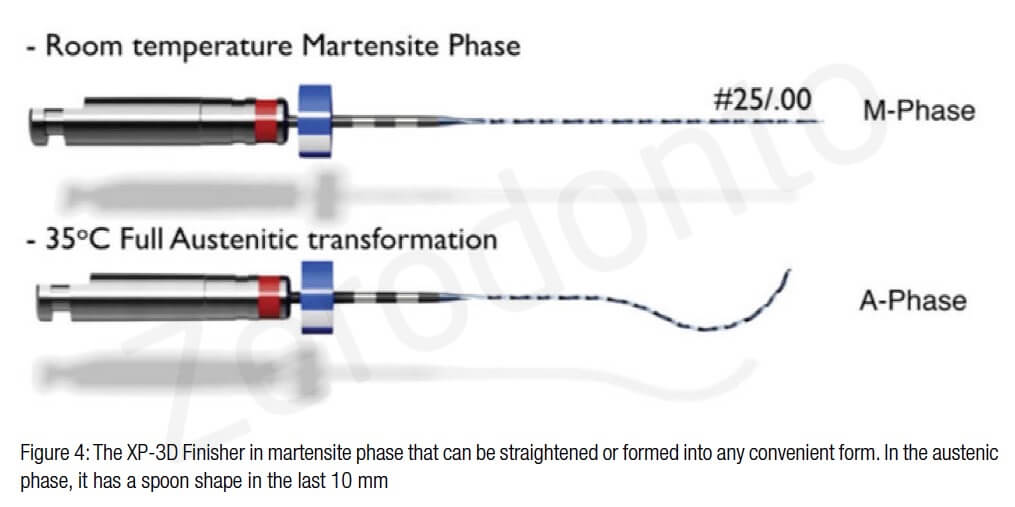
As it is an extremely slim and flexible file, due to the centrifugal force, it generates a movement that gives continually the working part different trajectories that allow it to come into contact with 80% of the canal surface within a minute of work [20]. (Fig4.)
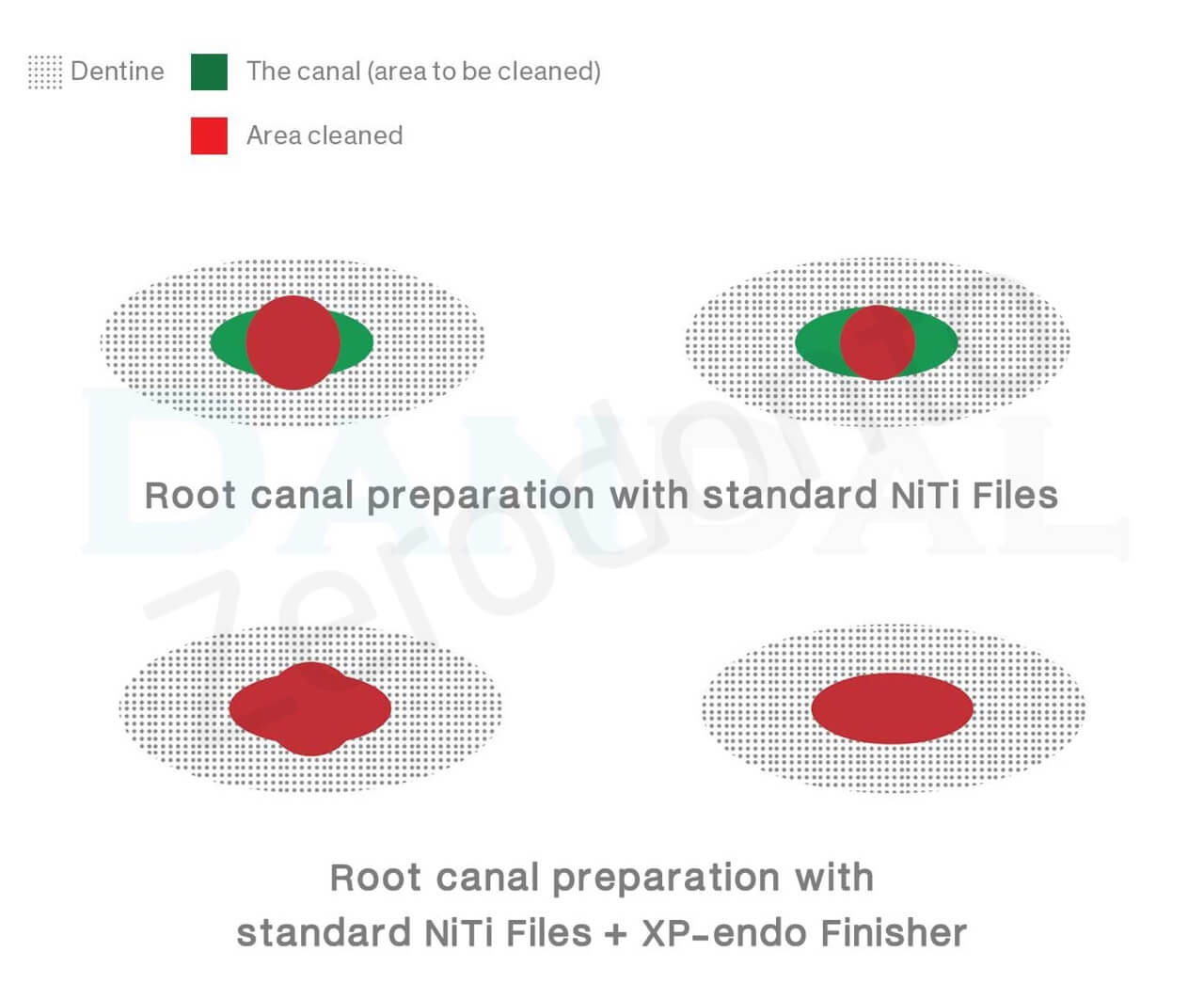
Several studies compared the XPEF cleansing capabilities to PUI ™, Vib-RingeSyringe ™ and PIPS, both in the phases of removal of dressing pastes (calcium hydroxide and antibiotics) [2,6,10, 11,12,13,14] and in those of removal of biofilm grown in the canals [1,8,9,15,16]
Considering not only the hypochlorite activation action but also the action of contact with the canal walls, the XPEF has proven to be the most effective in almost all situations (video2). Only in some cases it has proven to have a detergent capacity comparable to PUI, although in some work [2] it was not specified whether the irrigation solution was maintained above 35 ° C, a prerequisite to getting maximum performance from the instrument.
The comparative analysis between XPEF and the latest generation Ni-Ti instruments on the ability to disrupt biofilm confirmed that the latter still left a portion of unremoved bacteria in statistically significant values [1,9].
Further analysis was carried out on the amount of debris ejected from the apex during processing and it was estimated that the only working action of the XPEF does not produce significant debris [3] (comparable to the amount of pulp produced by the SAF) but it is the pre-operational operating sequence that determines a greater production.
A study by the Versiani group has shown that XPEF has better removed post-instrument debris in the lower molar roots, improving also the results obtained with the SAF ™ considered the gold standard for this purpose. [15]
Similar conclusions were drawn in this study by PUI, but the latter method only works to increase the action of the irrigants, but not to disaggregate the biofilm on the walls.
A study by Azim et al [5] evaluated the hypochlorite extrusion that could be caused by using XPEF, considering its swirling movement within the endodont, and it has emerged that comparing to Endovac@ the discharge of hypochlorite is bigger, but comparable to that of other systems in use such as Endoactivator @.
Clinically, it was also attempted to evaluate the possibility of removing gutta-percha from the canals using the XPEF at the end of ordinary sequences and, as already shown for the removal of dressing pastes, the file proved to be very effective [4,17] with statistically significant values, but still dependent on the maneuvers previously performed.
Unfortunately, the need to use preparatory methods before using XPEF did not solve the problem related to, for example, the formation of dentin crack, or the massive production of debris; as in some studies [3,17] the final quality of the result was often affected by the initial preparation performed.
To solve some of these problems, and to better define the concept of three-dimensional canal shaping, in 2016, FKG introduced on the market an instrument for shaping the entire endodontic: XP-Endo-Shaper ™ (XPES).
The instrument is still manufactured in Max-Wire ™ alloy, but has a 4% taper and an ISO # .30 apex. The anatomy of the instrument is unusual; in fact it is not the classic conical instrument that impresses its shape in the canal, but it has waves throughout its body which, during the expansive rotation phase, make the instrument impact the canal surface in the best way (Adaptive Core Tecnology).
The tip also has peculiarities (Booster-Tip). It has six cutting blades for optimum file guidance in the canal; the minimum diameter of the tip corresponds to an ISO # .15 reaching the maximum diameter of # .30. If used at body temperature, the instrument returns to the shape outlined for the austenitic phase; the rotation to which it is subjected (800 rpm), and its excellent flexibility make it possible to cover taper up to 8% and canalar diameters up to# .90. (fig5 -6)
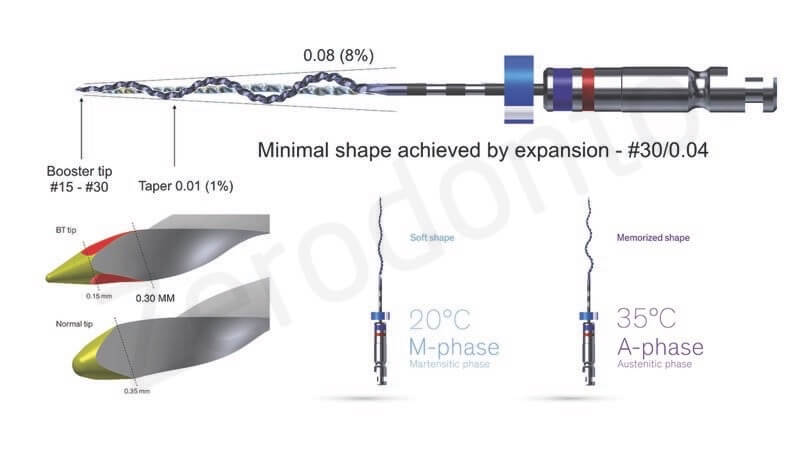
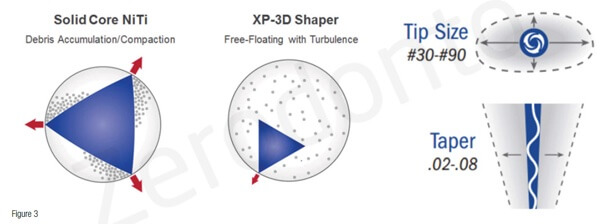
Initial studies carried out on micro CTs show how XPES can come into contact with most of the canal walls (fig. 7-8), and how it improves the cleansing of all the ovoid section apices.
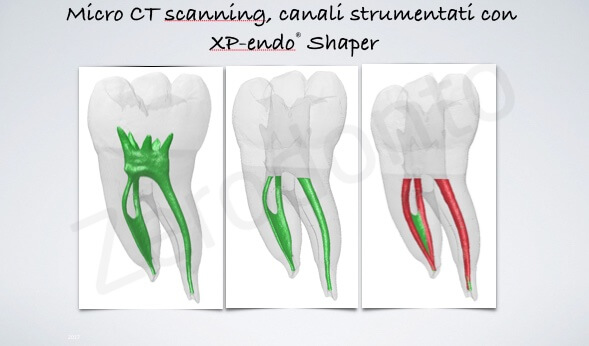
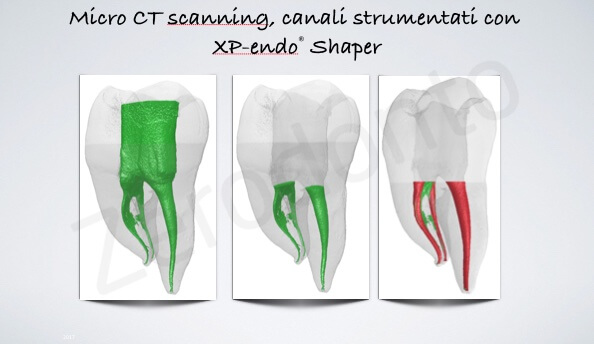
Moreover, considering that it works with a minimum torque (1 Nw), the risks of creating a dentin crack are minimized (video5) [18] and above all, the amount of debris produced by the processing is minimal (fig9).
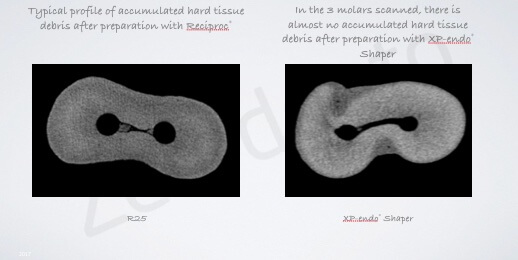
As with the XPEF, its austenitic shape is maintained above 35 ° C, so irrigants must maintain this temperature to have an optimal performance.
From torsional tests, XPES is rather delicate when compared to Flex-Master ™ (VDV), Pro-file Vortex Blue ™ (Dentply-Tulsa), and True Shape ™ (Dentsply-Tulsa) [19] but this is due to the own nature of the file, it does not need a torsional resistance because it does not work engaging in canal walls.
Its swirling movement does not allow the blades to engage in dentin, and this produces less stress on the walls and gives a greater amount of free space inside the canal in which the action of the irrigants can be better performed.
84% of free space created (compared to 46% of a conventional instrument) allows the debris to be suspended? And and helps to discharge them with the irrigants [21].
In the studies, the best results were obtained by continuous irrigation during the milling phase, both with XPEF and with XPES.
The instrument does not want to be a single file and contemplate an initial pre-flaring that has a dual function.
Firstly, the creation of an initial glidepath: especially if performed with rotating instruments [35,43] it minimizes the risk of altering the natural endodontic anatomy by also reducing the stress of the larger instruments.
Secondly, it is possible to reach a diameter of ISO # .15 (minimum 2% conicity) that allows the subsequent introduction of XPES.
The method involves coming and going movements from 3 to 5 times, trying to reach the apex. If this doesn’t work, the instrument is extracted and cleaned, the canal irrigated, and the same sequence restarts; Once LDL is reached, 10 up-down movements are to be performed along the canal.
This operation will give the canal the expected conicity and # .30 diameter.
Subsequently you can perform the final cleansing maneuvers to perform with the XPEF [22]
In 2017, FKG completes the range of these instruments with one dedicated to retreatment : the XP-EndoFinsher-R ™ (XPEF-R). The XPEF and XPES capability of removing gutta-percha has already been appreciated previously, with this new instrument with a stronger core than XPEF and a diameter of ISO.30 # in top (Fig10), the quality of cleaning would be superior , although some studies indicate that the difference in gutta clearance between XPEF and XPEF-R is not statistically significant [7].
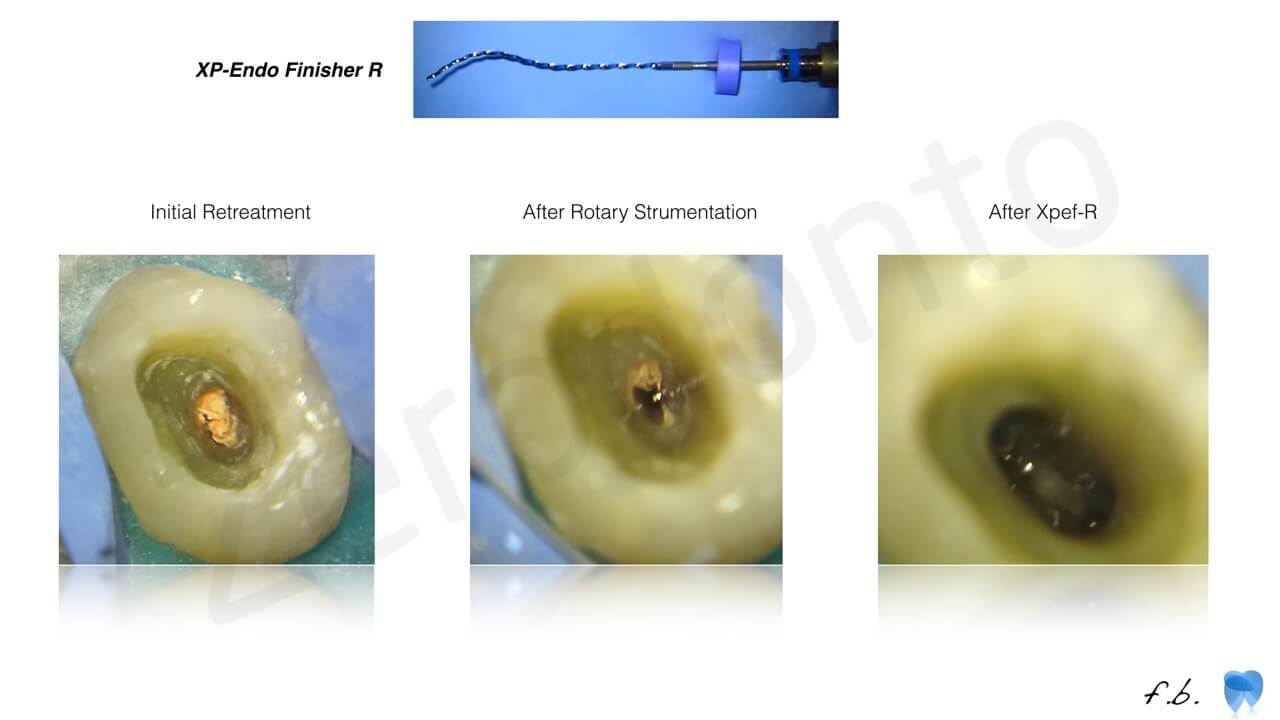
Once the canal is shaped and cleaned at best , it is possible to proceed with the closing phase using conventional methods, even if, in order to create a three-dimensional seal, this instrumental technique is well conceived both a conceptual and a clinical view by using bioceramics as sealer.
By doing so, the gutta cone only works as a carrier and a space keeper for any reprocessing, and all the clean space will be occupied by bioceramics. Thanks to their peculiar physical and chemical characteristics, they will adjust to the walls and seal the spaces that the gutta-percha could not reach, even with a vertical hot condensation (fig11)
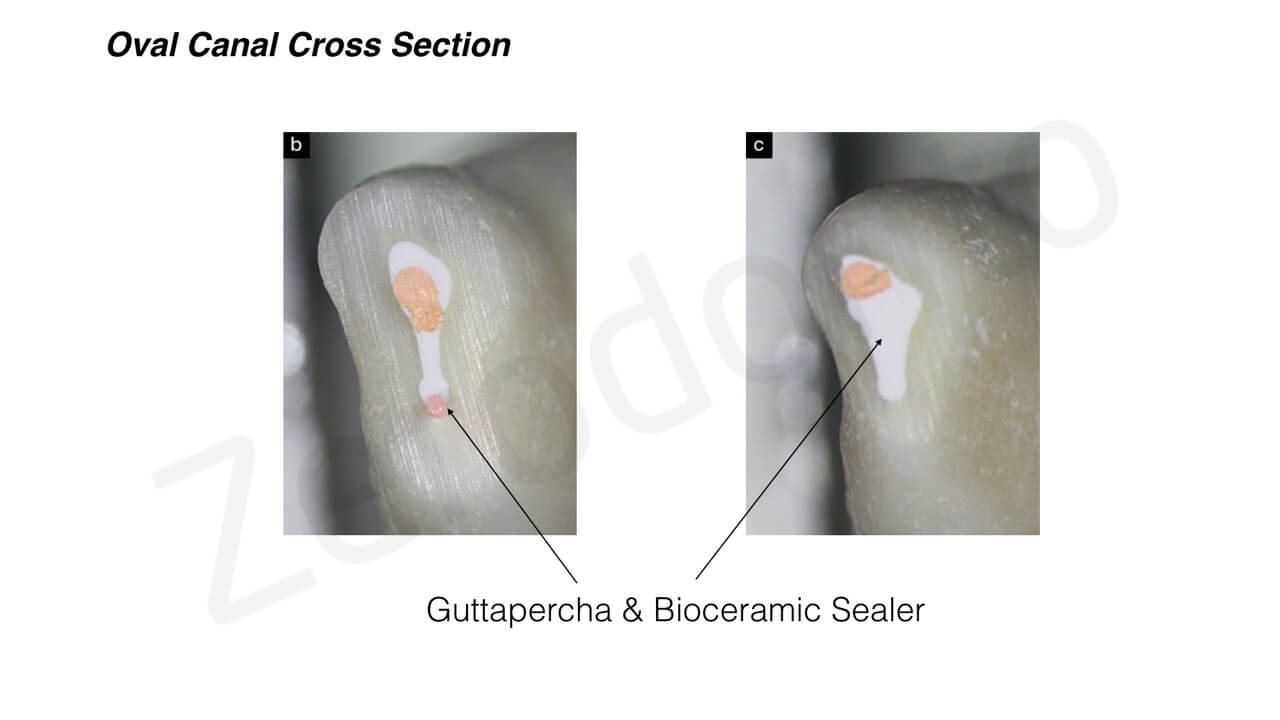
In addition, this eliminates the problem of the contraction of the material after cooling, which is known to be the cause of gaps on the canal walls, which can fail (Video 9).
Gentle File (Medic NRG)
Compared to the SAF and to the XP-Endo series, the Gentlefile (GF), is the one with the least “expandable” anatomical characteristics.
In fact, the instrument does not adapt strictly to the canal by compressing (squeezing) itself, but it exploits the rotation speed and the centrifugal force to reach the canal as close as possible.
Moreover, the instrument manufacturing bucks the trend, compared to latest instruments.
As a matter of fact, It is not made from NITI alloy, but from steel and characterized by a series of layers of spiral wrapped wires on a central stem.
The apical section is more flexible and varies depending on the diameters examined.
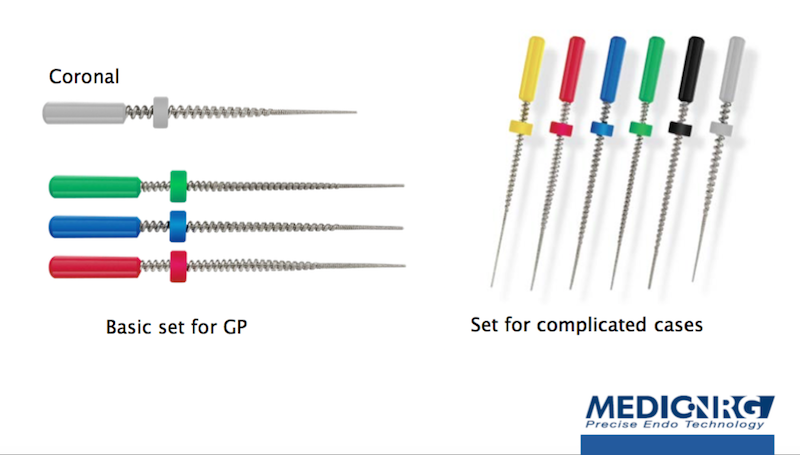
The surface roughness and the high rotation speed enables a close contact as possible, thus resulting in homogeneous and conservative removal of dentin.
The procedure implies the use of a set of 6 instruments , to be chosen depending on the type and complexity of the canal treated. The set also includes a finishing file (Finisher), which is used at the end of the shaping phase in order to improve the final cleaning , remove biofilm from the walls, thus enhancing the quality of subsequent canal filling.
The whirling effect which the irrigant undergoes (Tornado Disinfection System) enhance the penetration depth of hypochlorite into tubules and ensures a thorough cleaning, also evaluated by SEM analysis.
The finisher is characterized by steel fibers in the apical third; they open up, taking the shape of a brush, which ensures a conservative cleaning, without altering canal anatomy.
Unfortunately, only one study on the procedure has been reported in literature; it demonstrates how GF, compared to rotating NiTi instruments (Pro Taper Next, Revo- S), it has the same, but often a higher performance level, especially if we take into account cyclic fatigue resistance tests. The set also consists of a cordless handpiece with disposable heads (Fig. 3), which enables to get the right torque and rpm from the instrument ( the torque value is not specified by the manufacturer).
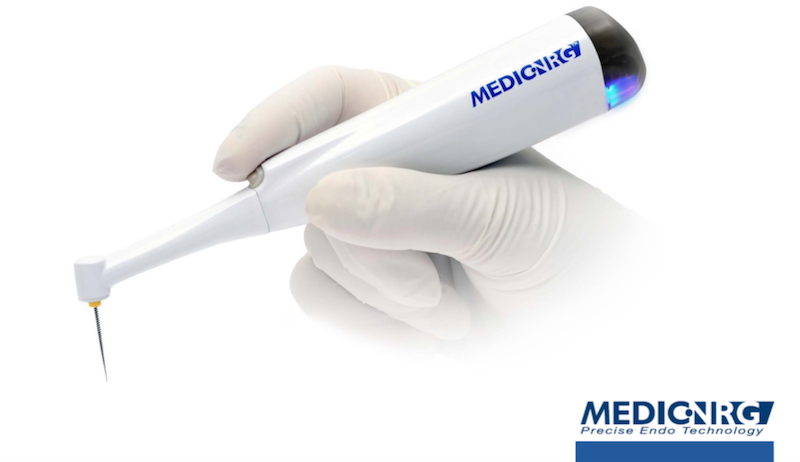
Unfortunately a clinical trial of the procedure has not been possible, since distribution is not guaranteed in Italy and in a large part of Europe and North America.
CLINICAL CASES
Clinical Case n. 1
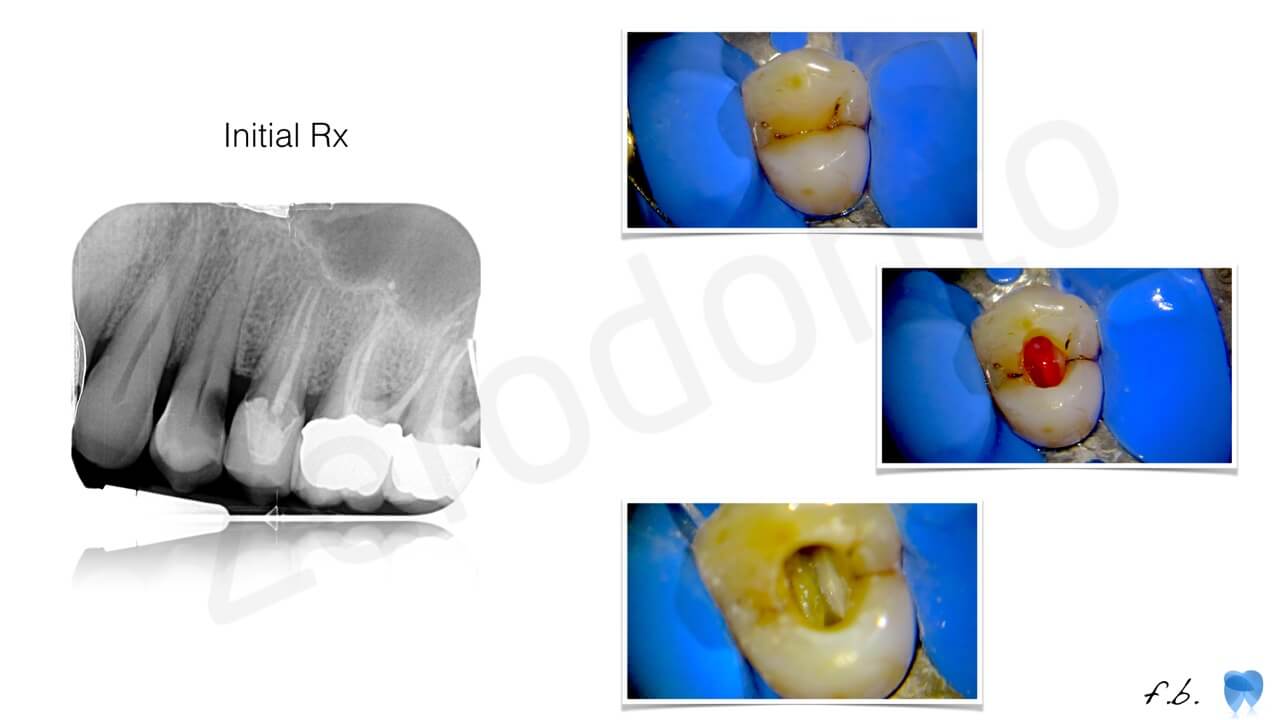
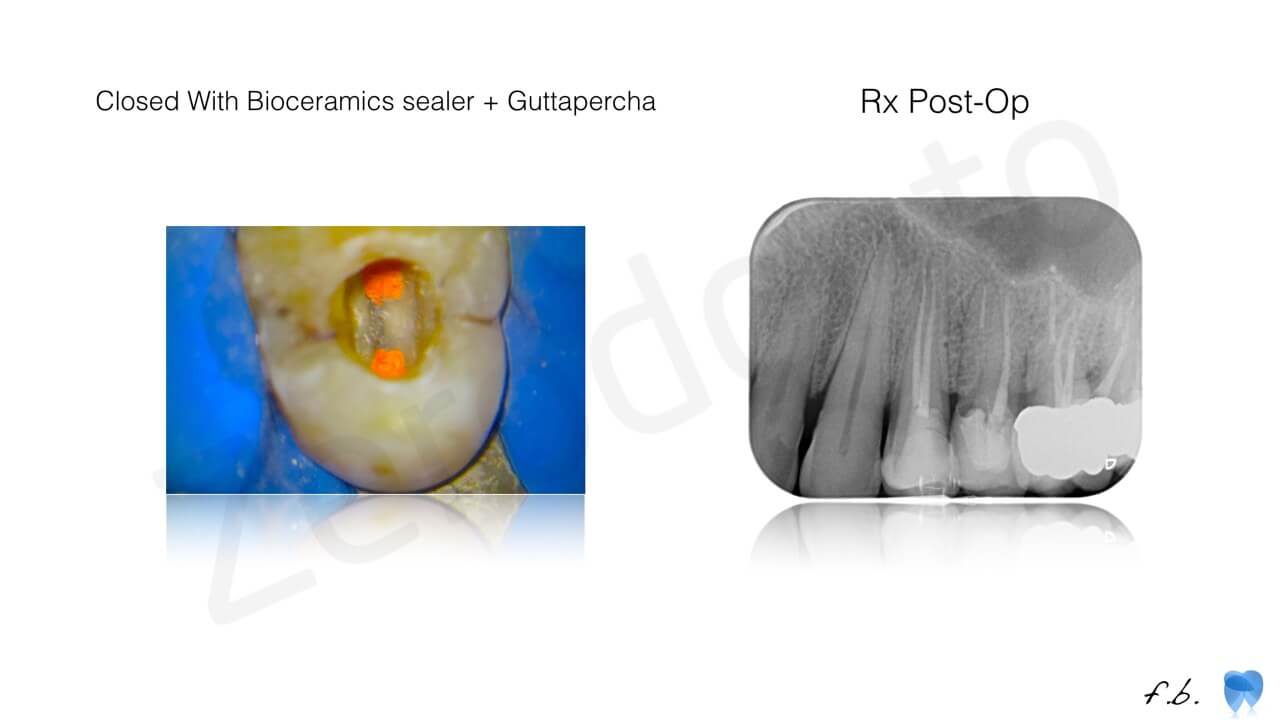
Clinical Case n. 2
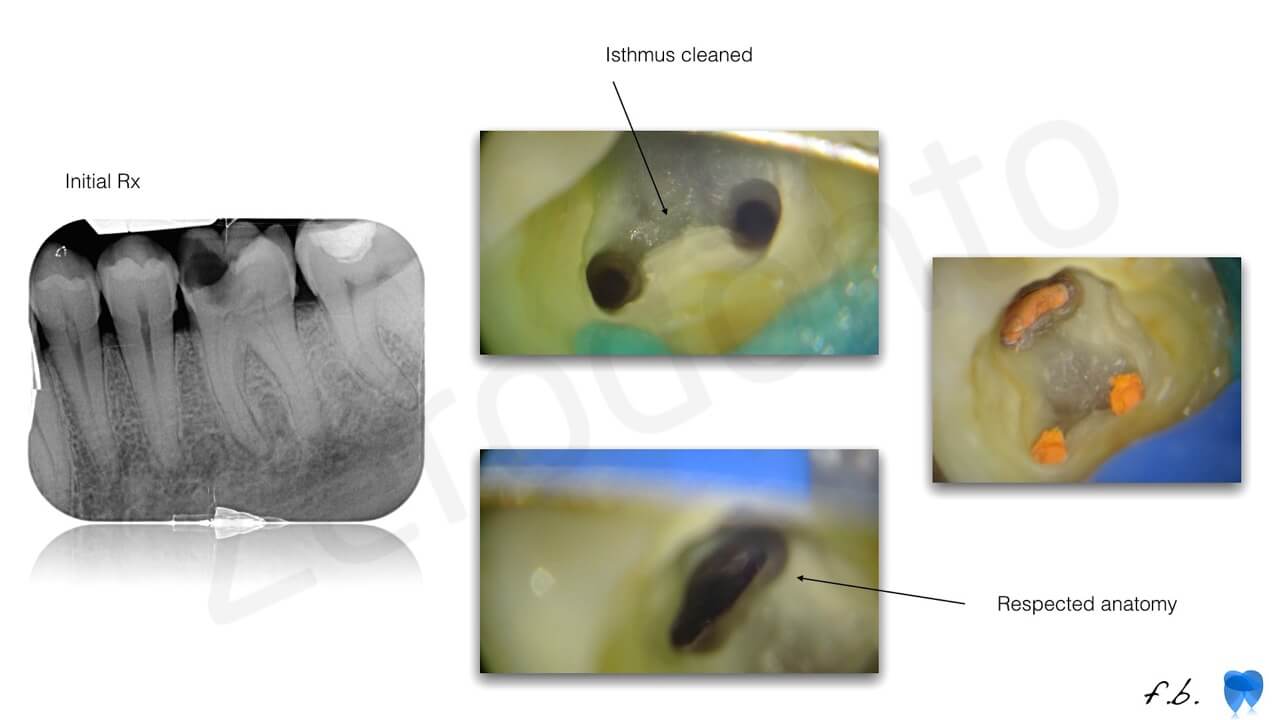
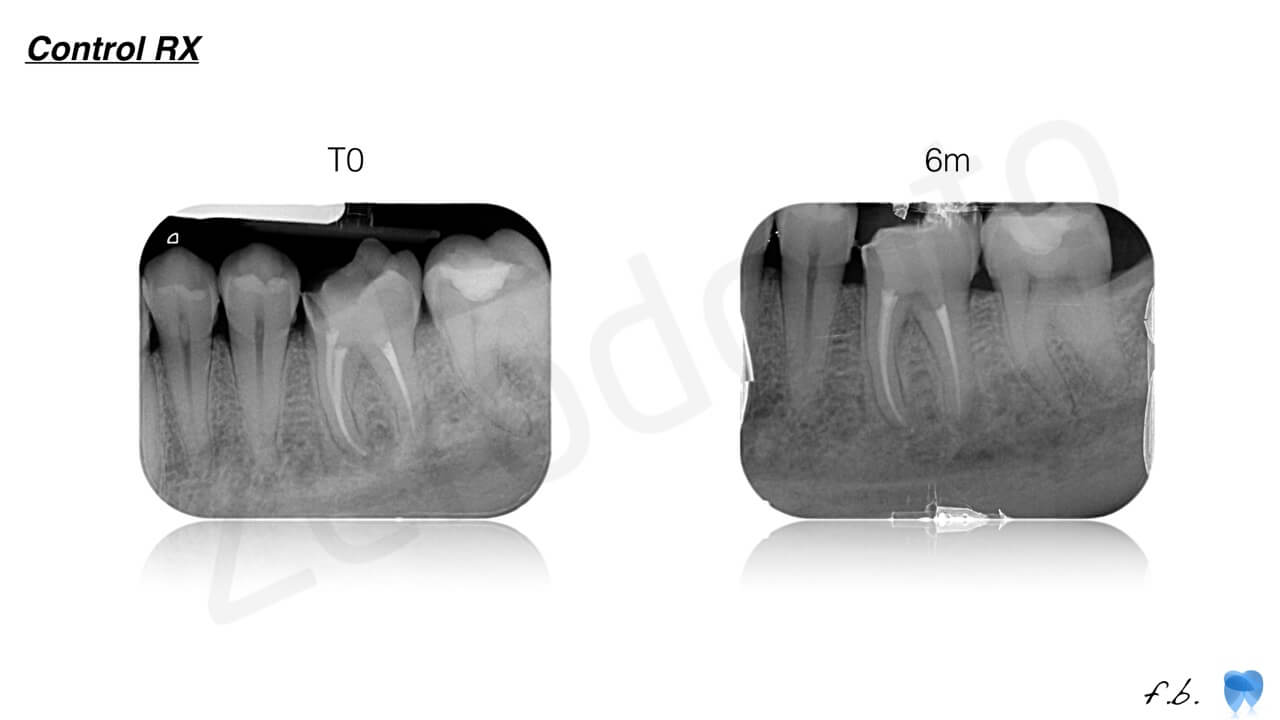
Clinical Case n. 3
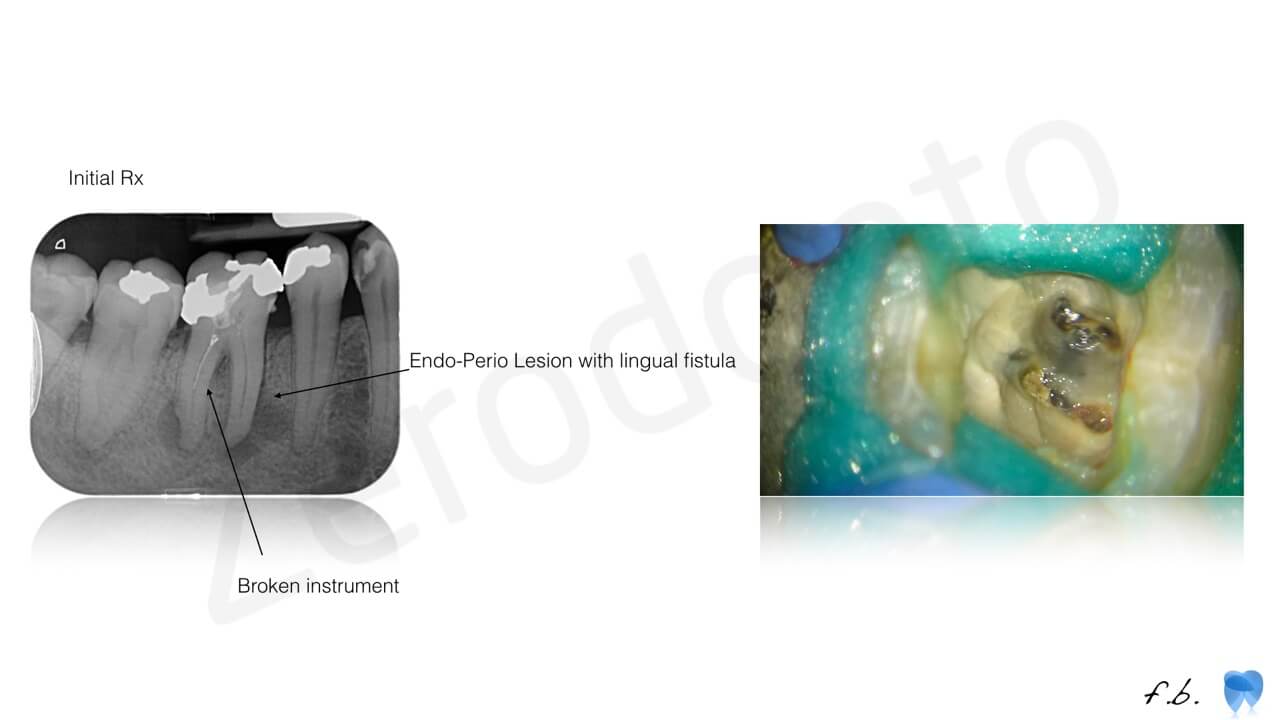
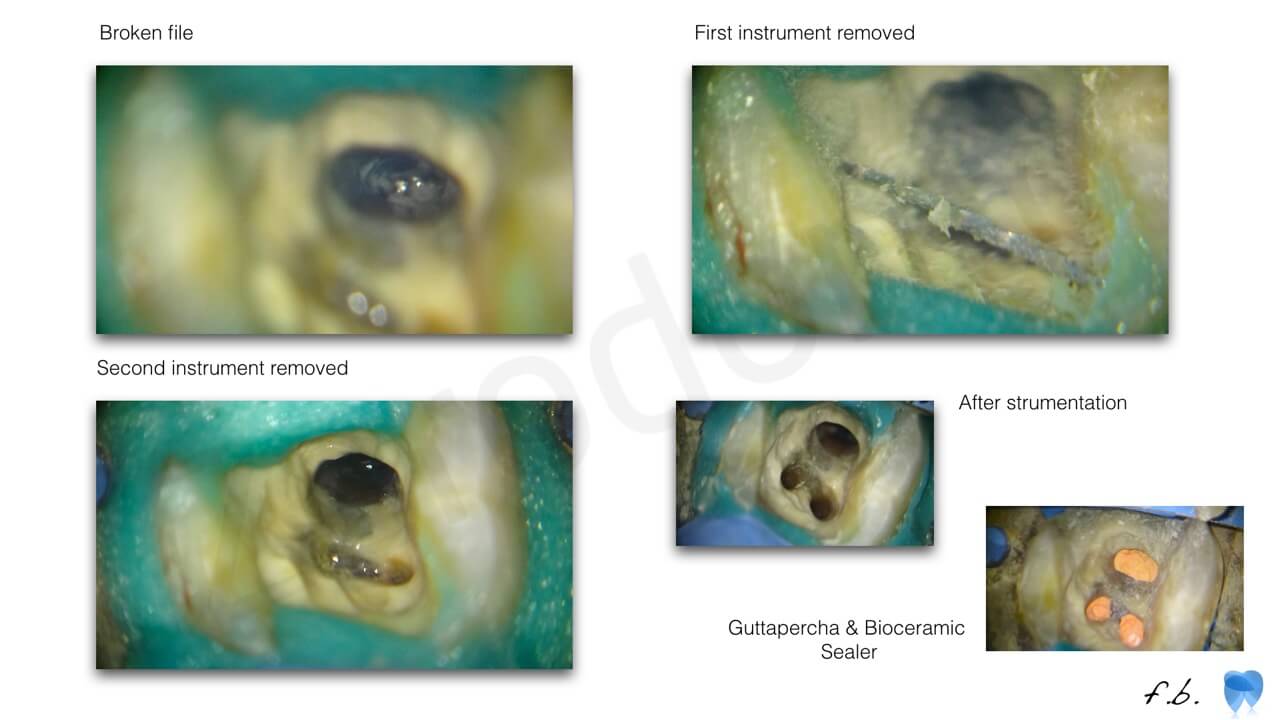
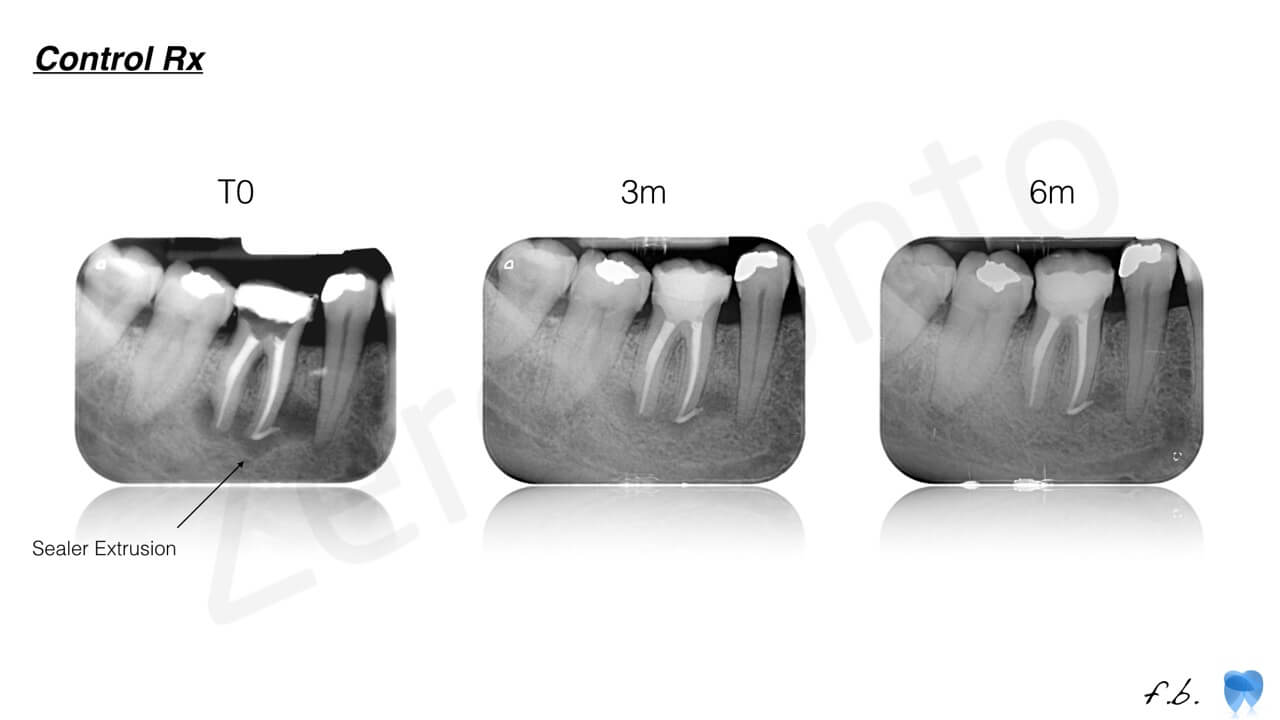
Clinical Case n. 4
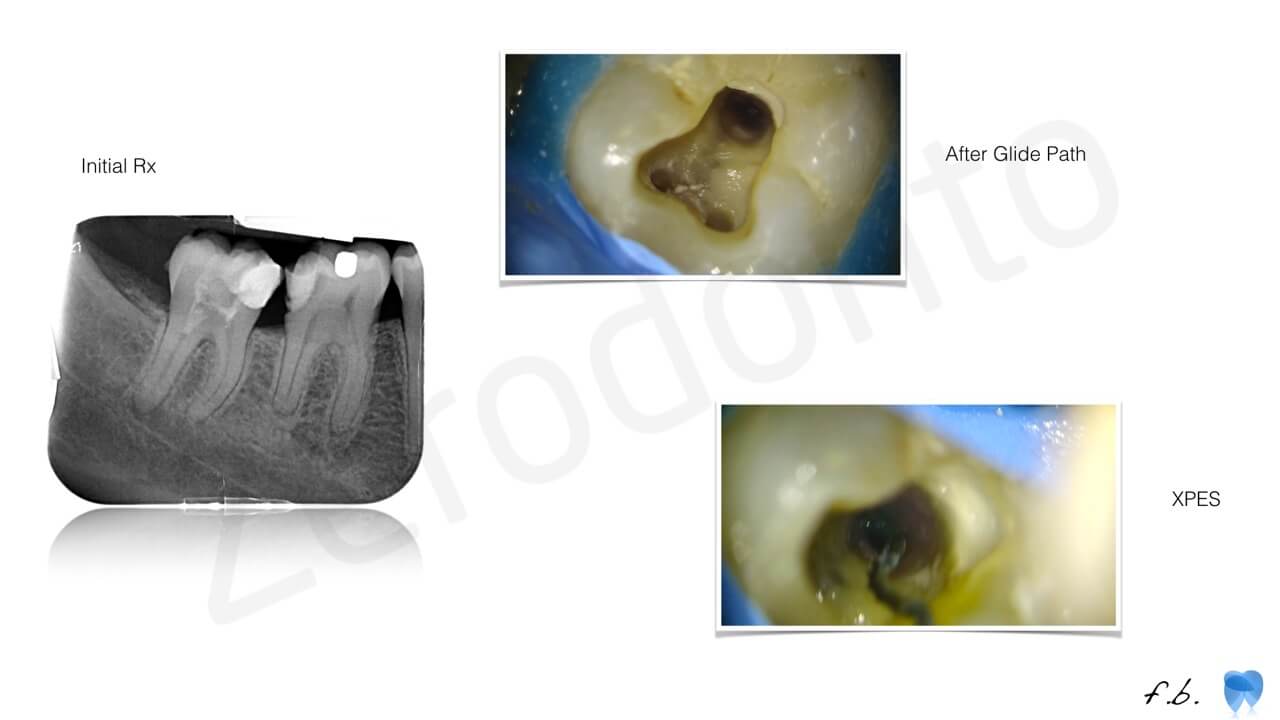
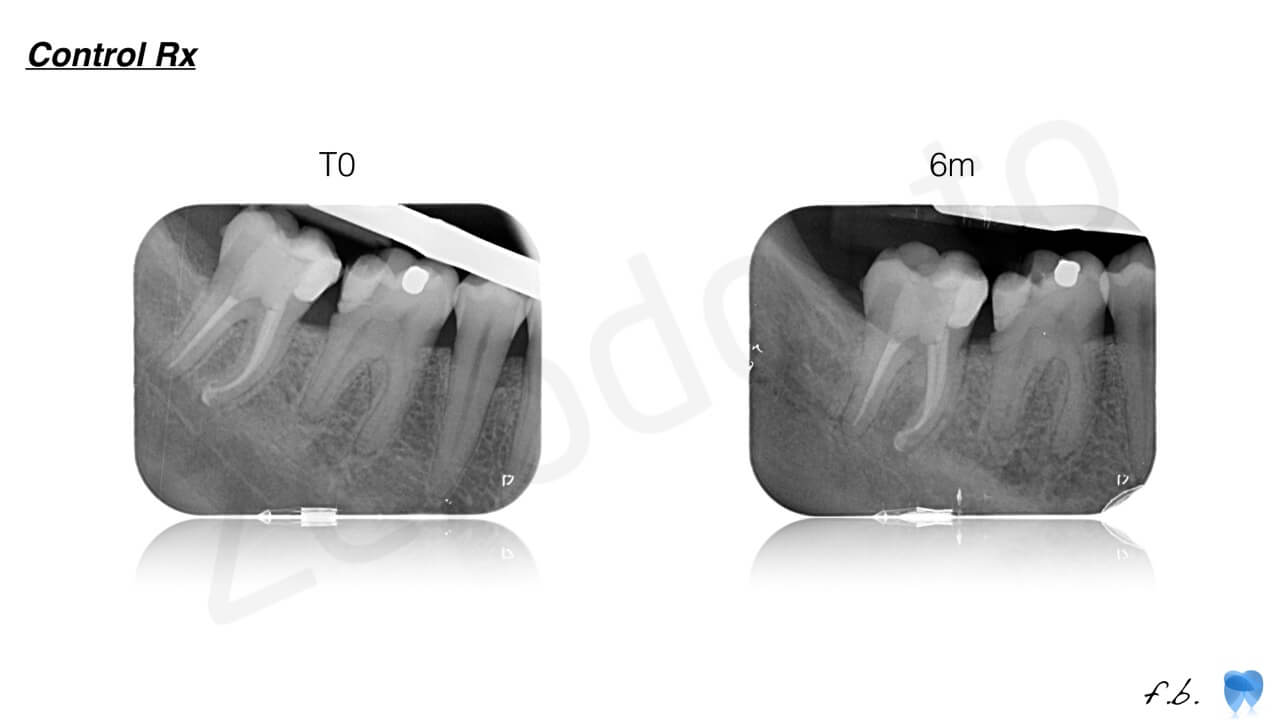
Clinical Case n. 5
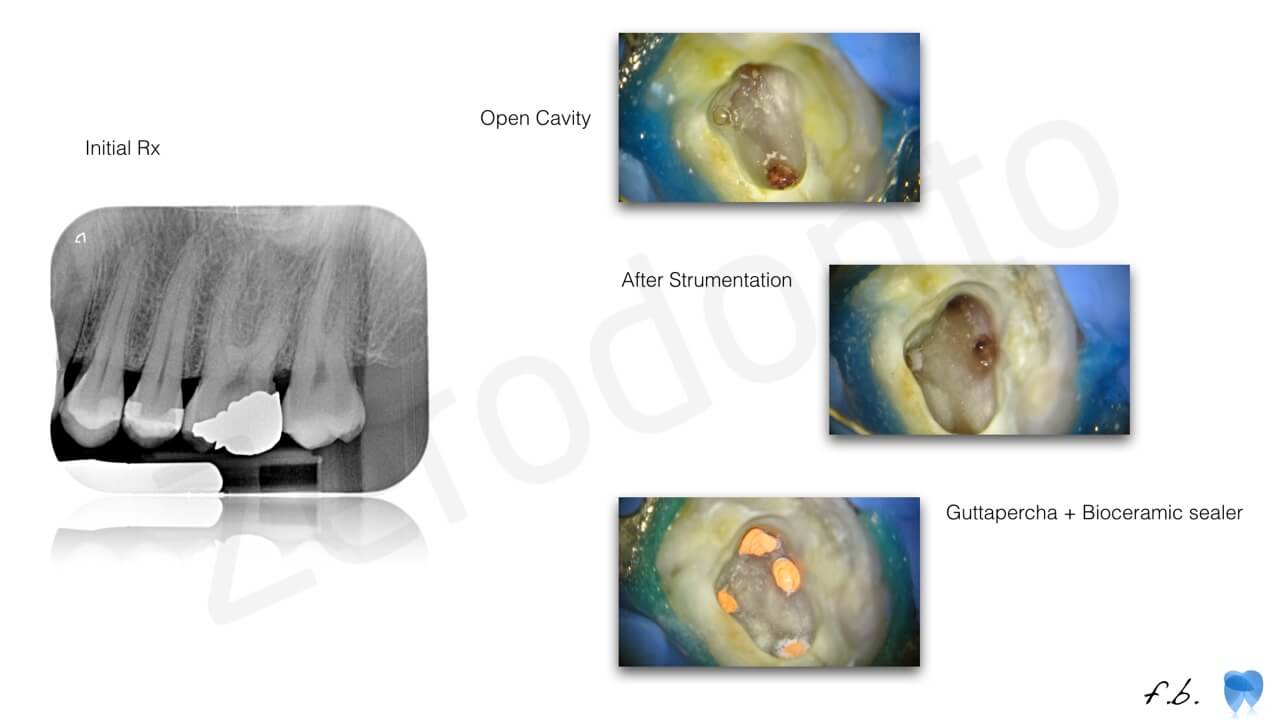
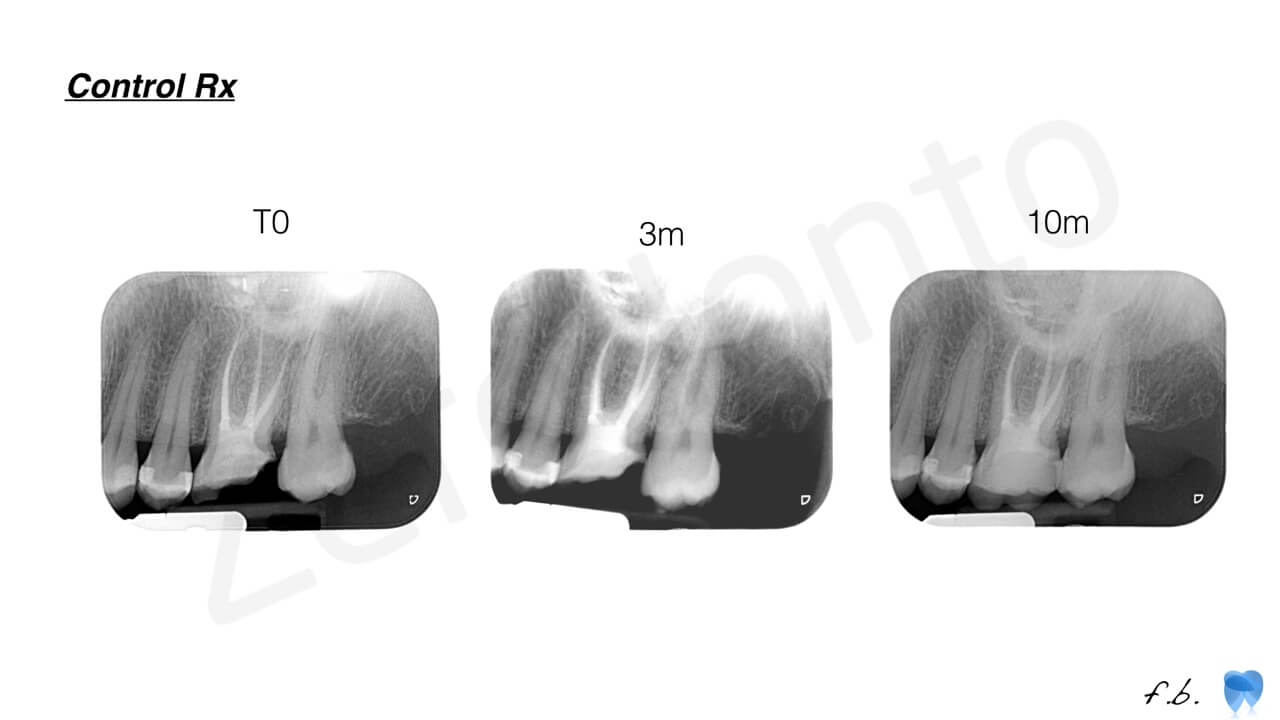
Clinical Case n. 6
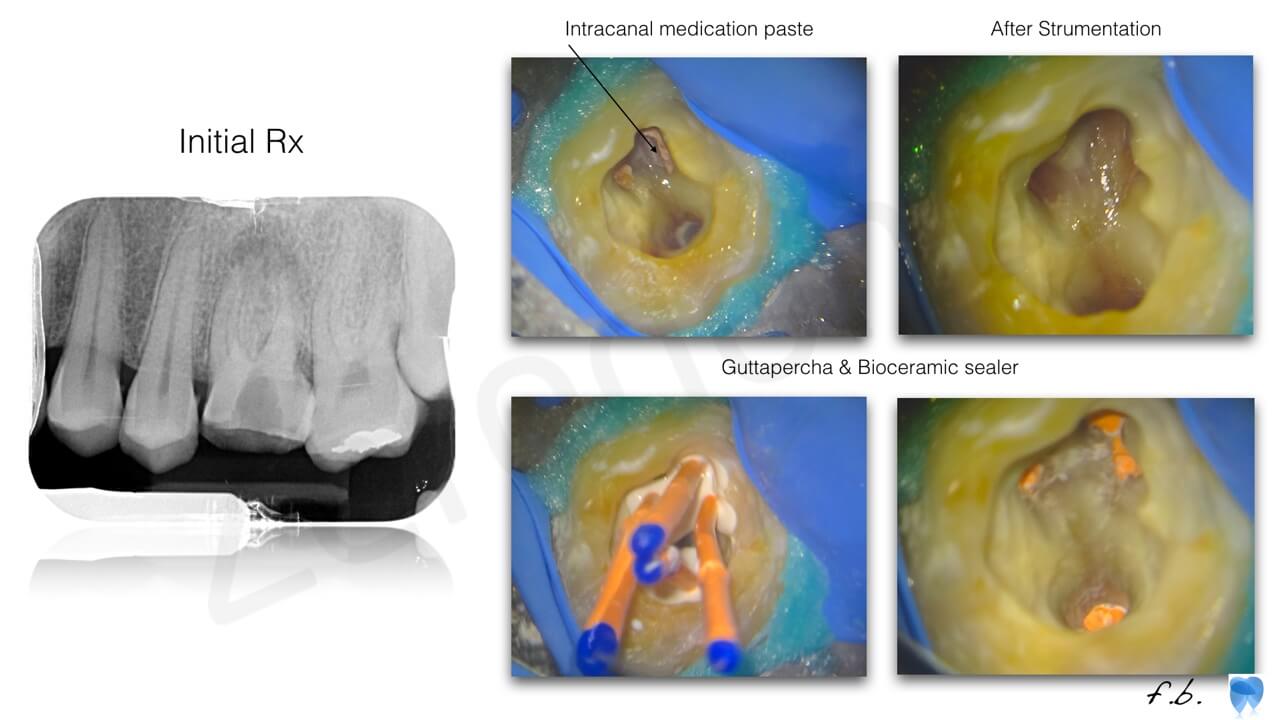
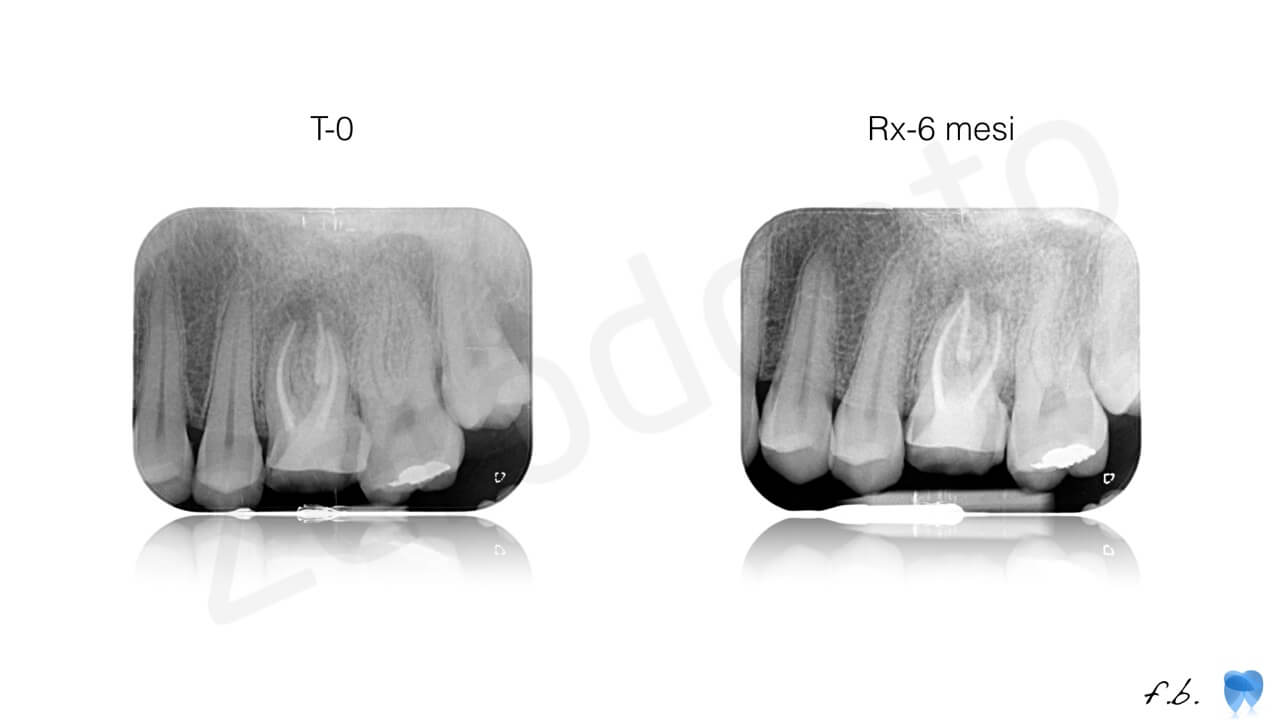
CONCLUSIONS
Clinical experience and research teach us that there is not yet a perfect method and a universal instrument to perform an endodontic treatment that makes it possible to clean the whole canal, but recent achievements have certainly allowed us to move forward in order to reduce the risks of failure and increase healing percentage.
We will certainly need further studies to confirm the efficacy of the new alloys and various shaping methods, but the initial clinical experience
with the Xp Endo system, combined with easiness of use and the results highlighted by literature, is very promising.
REFERENCES
1– Adjunctive Steps for Disinfection of the Mandibular Molar Root Canal System: A Correlative Bacteriologic, Micro- Computed Tomography, and Cryopulverization Approach.
Alves FR, Andrade-Junior CV, Marceliano-Alves MF, Pérez AR, Rôças I, Versiani , Sousa Neto , Provenzano JC, Siqueira JF Jr.
Endod. 2016 Nov;42(11):1667-1672. doi: 10.1016/j.joen.2016.08.003. Epub 2016 Sep 15.
2–An in vitro evaluation of various irrigation techniques for the removal of double antibiotic paste from root canal surfaces.
Gokturk H, Ozkocak I, Buyukgebiz F, Demir O.
J Appl Oral Sci. 2016 Nov-Dec;24(6):568-574. doi: 10.1590/1678-7757
3– Apical extrusion of debris during the preparation of oval root canals: a comparative study between a full-sequence SAF system and a rotary file system supplemented by XP-endo finisher file.
Kfir A, Moza-Levi R, Herteanu M, Weissman A, Wigler R.
Clin Oral Investig. 2017 Jun 12. doi: 10.1007/s00784-017-2144-9
4 – Cleanliness of Canal Walls following Gutta-Percha Removal with Hand Files, RaCe and RaCe plus XP-Endo Finisher Instruments: A Photographic in Vitro Analysis.
Karamifar K1, Mehrasa N1, Pardis P1, Saghiri MA2.
Iran Endod J. 2017 Spring;12(2):242-247. doi: 10.22037/iej.2017.47.
5– Comparison of sodium hypochlorite extrusion by five irrigation systems using an artificial root socket model and a quantitative chemical method.
Azim AA, Aksel H, Margaret Jefferson M, Huang GT.
Clin Oral Investig. 2017 Jul 26. doi: 10.1007/s00784-017-2187-y. [Epub ahead of print]
6– Effectiveness of various irrigation protocols for the removal of calcium hydroxide from artificial standardized grooves.
Gokturk H, Ozkocak I, Buyukgebiz F, Demir O.
J Appl Oral Sci. 2017 May-Jun;25(3):290-298. doi: 10.1590/1678-775
7– Effectiveness of XP-endo Finisher and XP-endo Finisher R in removing root filling remnants: a micro-CT study.
Silva EJNL, Belladonna FG, Zuolo AS, Rodrigues E, Ehrhardt IC, Souza EM, De-Deus G.
Int Endod J. 2017 May 3. doi: 10.1111/iej.12788.
8-Effectiveness of XP-endo Finisher, EndoActivator, and File agitation on debris and smear layer removal in curved root canals: a comparative study.
Elnaghy AM, Mandorah A, Elsaka SE
Odontology. 2017 Apr;105(2):178-183. doi: 10.1007/s10266-016-0251-8. Epub 2016 May 20.
9-Efficacy of 4 Irrigation Protocols in Killing Bacteria Colonized in Dentinal Tubules Examined by a Novel Confocal Laser Scanning Microscope Analysis.
Azim AA, Aksel H, Zhuang T, Mashtare T, Babu JP, Huang GT
J Endod. 2016 Jun;42(6):928-34. doi: 10.1016/j.joen.2016.03.009. Epub
10– Efficacy of self-adjusting file, XP-endo finisher and passive ultrasonic irrigation on the removal of calcium hydroxide paste from an artificial standardized groove.
Kfir A, Blau-Venezia N, Goldberger T, Abramovitz I, Wigler R.
Aust Endod J. 2017 Jun 23. doi: 10.1111/aej.12204.
11– Efficacy of XP-endo finisher and TRUShape 3D conforming file compared to conventional and ultrasonic irrigation in removing calcium hydroxide.
Uygun AD, Gündoğdu EC, Arslan H, Ersoy İ.
Aust Endod J. 2016 Nov 12. doi: 10.1111/aej.12176.
12– Efficacy of XP-endo Finisher File in Removing Calcium Hydroxide from Simulated Internal Resorption Cavity.
Keskin C, Sariyilmaz E, Sariyilmaz Ö.
J Endod. 2017 Jan;43(1):126-130. doi: 10.1016/j.joen.2016.09.009. Epub 2016 Dec 6.
13-Efficacy of XP-endo finisher files in the removal of calcium hydroxide paste from artificial standardized grooves in the apical third of oval root canals.
Wigler R, Dvir R, Weisman A, Matalon S, Kfir A.
Int Endod J. 2017 Jul;50(7):700-705. doi: 10.1111/iej.12668. Epub 2016 Jun 25.
14– Efficacy of XP-Endo Finisher in the Removal of Triple Antibiotic Paste from Immature Root Canals.
Turkaydin D, Demir E, Basturk FB, Sazak Övecoglu H.
J Endod. 2017 Jul 13. pii: S0099-2399(17)30523-X. doi: 10.1016/j.joen.2017.04.017
15– Ex vivo evaluation of four final irrigation protocols on the removal of hard-tissue debris from the mesial root canal system of mandibular first molars.
Leoni GB, Versiani MA, Silva-Sousa YT, Bruniera JF, Pécora JD, Sousa-Neto MD
Int Endod J. 2017 Apr;50(4):398-406. doi: 10.1111/iej.12630. Epub 2016 Apr 8.
16– In Vitro Efficacy of XP-endo Finisher with 2 Different Protocols on Biofilm Removal from Apical Root Canals.
Bao P, Shen Y, Lin J, Haapasalo M
J Endod. 2017 Feb;43(2):321-325. doi: 10.1016/j.joen.2016.09.021. Epub 2016 Dec 7
17–Removal of Root Canal Fillings in Curved Canals Using Either Reciprocating Single- or Rotary Multi-instrument Systems and a Supplementary Step with the XP-Endo Finisher.
Alves FR, Marceliano-Alves MF, Sousa JC, Silveira SB, Provenzano JC, Siqueira JF Jr.
J Endod. 2016 Jul;42(7):1114-9. doi: 10.1016/j.joen.2016.04.007. Epub 2016 May 20.
18– Effect of ProTaper Gold, Self-Adjusting File, and XP-endo Shaper Instruments on Dentinal Microcrack Formation: A Micro-computed Tomographic Study.
Bayram HM, Bayram E, Ocak M, Uygun AD, Celik HH
J Endod. 2017 Jul;43(7):1166-1169. doi: 10.1016/j.joen.2017.02.005. Epub 2017 May 2.
19– Torsional resistance of XP-endo Shaper at body temperature compared with several nickel-titanium rotary instruments.
Elnaghy AM, Elsaka SE
Int Endod J. 2017 Jul 12. doi: 10.1111/iej.12815.
20– Xp-3D Finisher@ file- the next step in restorative endodontics
M.Trope, G. Debellian
Endodontic Practice US2015; Volume 8, Issue 8, p 14-16
21– Cleaning the third dimension.
M.Trope, G. Debellian
Endodontic Practice US 2015; Volume 8, issue6, p22-24
22– Anatomical shaping with 3-D Shaper and Finisher
Endodontic Practice US 2017; Volume 10, issue1, p 30-32
Allen ALì Nasseh
23– Endodonzia, trincipi di base, procedure operative e tecniche (sec Edizione)
Edito da Edra
Somma F. et al
24– Cyclic fatigue testing of nichel-titanium endodontic instrument
J.Endod 1997; 23 (2) : 77-85
Pruett JP., et al
25– Rotazione alternata nell’uso di strumenti Ni-Ti
G .It Endo – vol 16-n2, p 79-84
Malentacca A., Lalli F.
26– Extending cyclec fatigue life of F2 Pro-Taper instruments used in reciprocating movement
Int. Endod J 2010
De Deus G. et al
27– Cyiclic fatigue analysis of twisted file rotary NiTi instruments used in reciprocating motion
Gambarini G. et al
J. Endod 2012; 45 (9) :802-6
28- Apically extruded debris with reciprocating single-file and full-sequence rotary instrumentation system
Burklein S, Shafer E.
J Endod 2012 ; 38(6); 850-2
29– Incidence of dentinal defects after root canal preparation: reciprocating versus rotary instrumentation
Burkein S. et al
J.Endod 2013; 39: 501-4
30– Cyclic fatigue resistance of race and M-Two files in continuos rotation and reciprocating motion
Vadhana S. et al
J. Endod 2014 Jul; 40(7): 995-9
31– Influence of continuos rotation or reciprocation of OTR motion on cyclic fatigue resistance of Ni-Ti rotary instruments
Int.Endod.Journ
Pedullà E., Cosentino G., Ambu E., Rovai F., Campedelli F., Rapisarda S., La Rosa GR., Rapisarda E., Grandini S.
32-Current Challenges and concepts of the thermomechanical treatment of Ni-Ti instruments
Shen, Zhou, Zheng; Peng; Haapasalo
JOE, vol 39, numb 2, February 2013
33– Torsional Andcycling fatigue resistance of a new Ni-Ti instrument manufactured by electrical discharge machining
E.Pedullà, F.LSavio, S.Boninelli, G. Plotino, N.M.Grande, G.L.Rosa, E.Rapisarda
34- Influence of Cyclic torsional preloading on cyclic fatigue resistance of Ni-Ti instruments
E. Pedullà, F.Lo Savio, S. Boninelli, G.Plotino, N.M.Grande, E. Rapisarda, G.La Rosa
International Endod. Journal
35– Computed Micro-Tomography evaluation of glide path with nickel-titanium rotary PathFiles in maxillary first molars curved canals.
Pasuqlaini D et al
Journal of Endodontics 2012; 38(3): 389-93
36-. Accumlated hard tissue debris levels in mesial roots of ,mandibular molars after sequential irrigation steps.
Paqué F, Boessler C, Zehender M
Int Endod J 2011;44:148-53
37– Preparatinj of oval-shaped root canals in mandibular molars using Ni-Ti rotary instruments: A micro-computed tomography study.
Paqué F, Ballmer M, Attin T, Peters OA.
J Endod 2010;36:703-7
38– The effects of canal preparation and filling on the incidence of dentinal defects.
Shemesh H, Bier CA, Wu MK, TanomaruFilho M, Wesselink PR.
Int J Endod 2009;42:208-13
39-Analisys of apical root trasportation associated with Pro taper universal F3 and F4instruments by using digital subtraction radiology.
Kunert GG, Camargo Fontanella VR, de Moura AA, Barletta FB.
J Endod 2010;36:1052-5
40-. Preparatinj of oval-shaped root canals in mandibular molars using Ni-Ti rotary instruments: A micro-computed tomography study.
Paqué F, Ballmer M, Attin T, Peters OA
J Endod 2010;36:703-7
41– Micro computed tomography evaluation of the preparation of long oval root canals in mandibular molars with SAF.
Paqué F, Peters OA.
J Endod 2011;37:517-21
42– Effect of photon-initiated photo acoustic streaming on removal of apically placed dentinal debris
Arslan, Capar, Saygili, Gok, Akcay
Int. Endodo Journ 2014; 47(11): 1072-7
43- Use of NiTi rotary PathFile to create the glide path: comparison with manual preflaring in simulated root canals
Journal of Endodontics 2009; 35 (3): 408-12
Berutti E et Al.
43- Three-Dimensional Anatomic Cleaning and Shaping
Allen Nasseh Alì.
Dentistry Today ,1 July2017
44- Evaluation of Time to Fracture and Vertical Forces Applied by a Novel Gentlefile System for Root Canal Preparation in Simulated Roots Canal
D. Moreinos, A.Dakar, N.J. Stone, J. Moshonov
Journal Of Endodontic 2016; 42(3), 505-508

